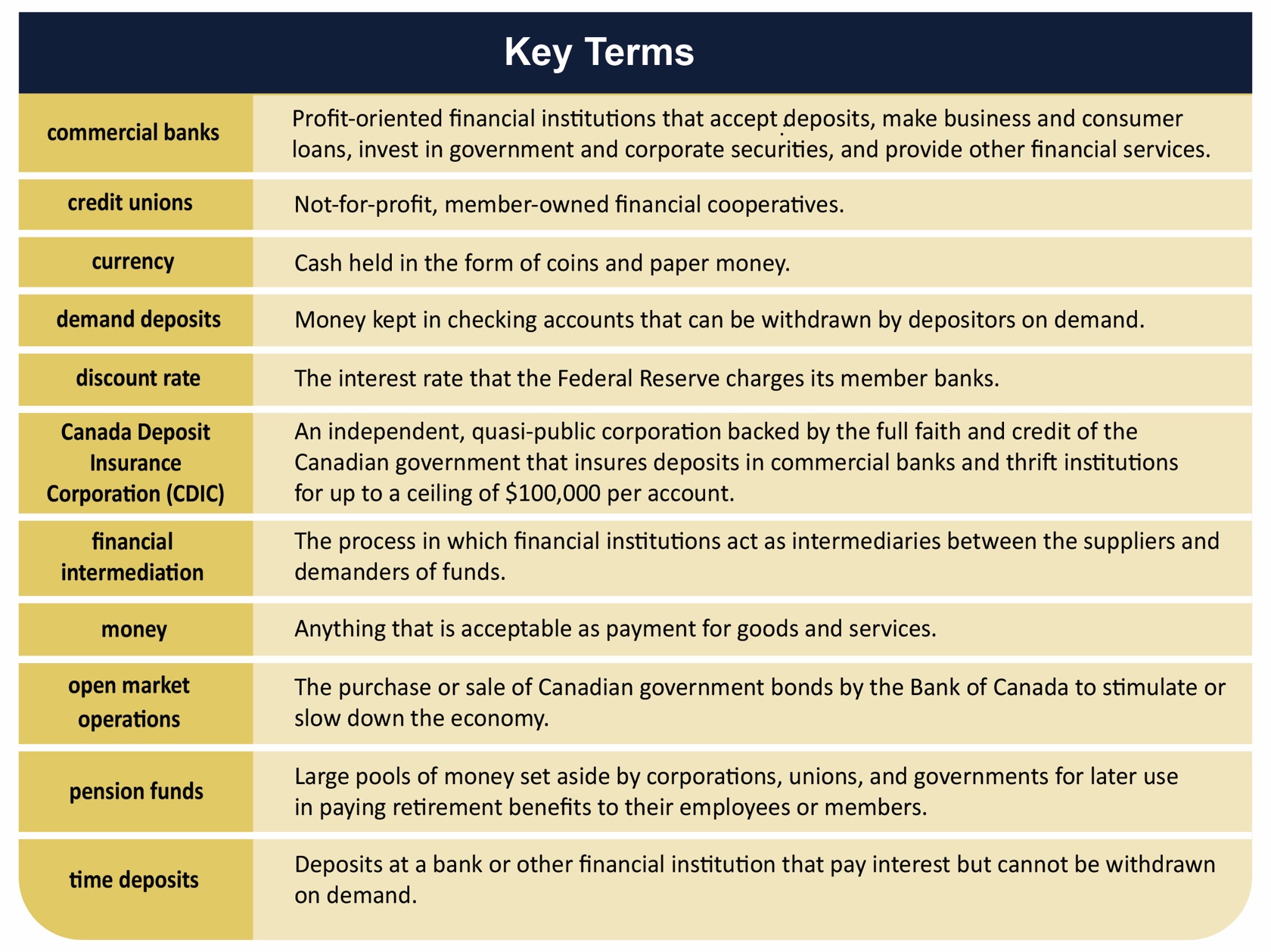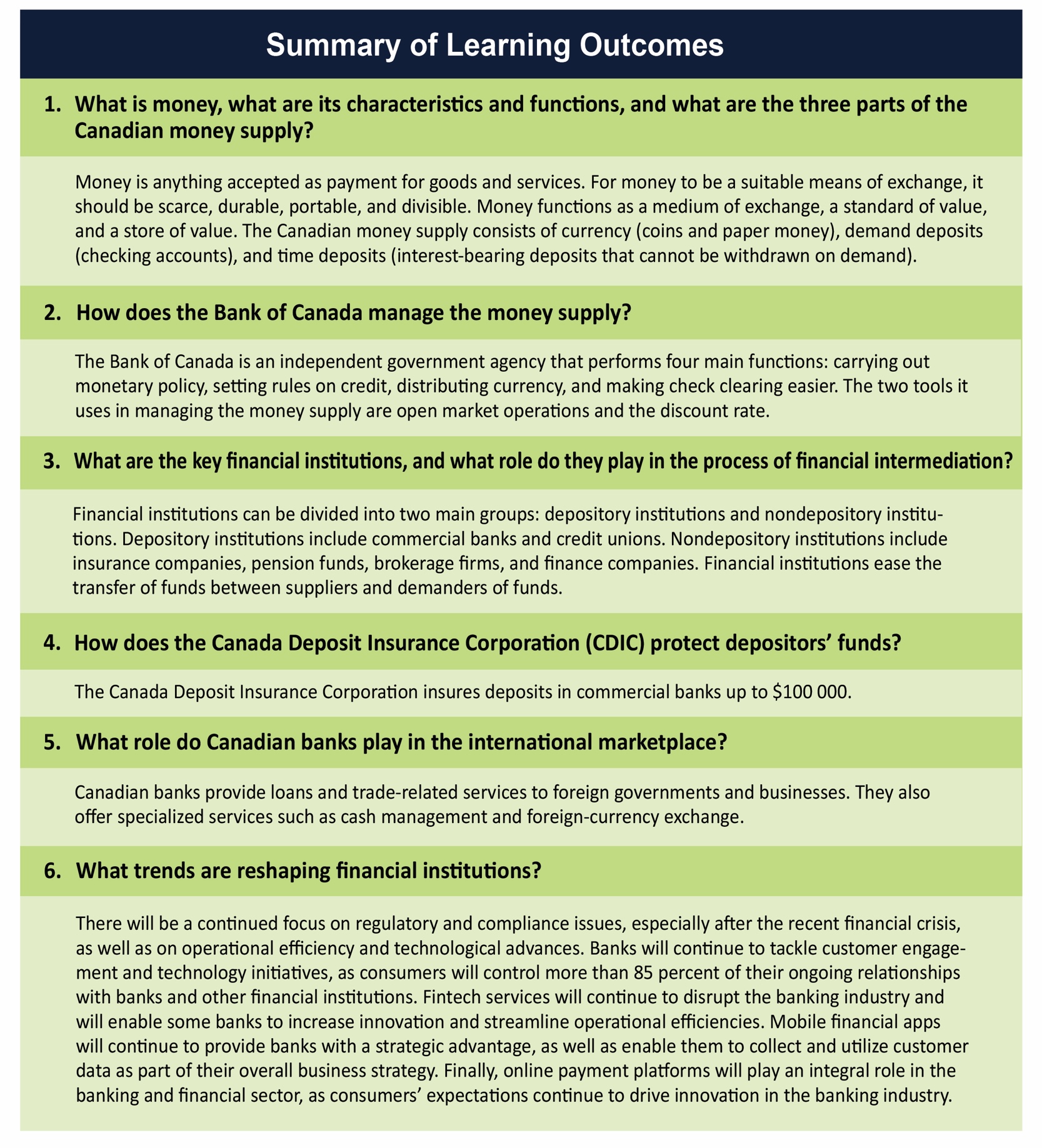Chapter 7: Money and Banking

Learning Objectives
After reading this chapter, you should be able to answer these questions:
- What is money, what are its characteristics and functions, and what are the three parts of the Canadian money supply?
- How does the Bank of Canada manage the money supply?
- What are the key financial institutions, and what role do they play in the process of financial intermediation?
- How does the Canada Deposit Insurance Corporation (CDIC) protect depositors’ funds?
- What trends are reshaping financial institutions?
7.1 Show Me the Money
What is money, what are its characteristics and functions, and what are the three parts of the Canadian money supply?
Money is anything that is acceptable as payment for goods and services. It affects our lives in many ways. We earn it, spend it, save it, invest it—and often wish we had more of it. Businesses and governments use money in similar ways. Both require money to finance their operations. By controlling the amount of money in circulation, the federal government can promote economic growth and stability. For this reason, money has been called the lubricant of the machinery that drives our economic system. Our banking system was developed to ease the handling of money.
Characteristics of Money
For money to be a suitable means of exchange, it should have these key characteristics:
- Scarcity: Money should be scarce enough to have some value but not so scarce as to be unavailable. Pebbles, which meet some of the other criteria, would not work well as money because they are widely available. Too much money in circulation increases prices and inflation. Governments control the scarcity of money by limiting the quantity of money in circulation.
- Durability: Any item used as money must be durable. A perishable item such as a banana becomes useless as money when it spoils. Even early societies used durable forms of money, such as metal coins and paper money, which lasted for a long time.
- Portability: Money must be easily moved around. Large or bulky items, such as boulders or heavy gold bars, cannot be transported easily from place to place.
- Divisibility: Money must be capable of being divided into smaller parts. Divisible forms of money help make transactions of all sizes and amounts possible.
Functions of Money
Using a variety of items as money would be confusing. Thus, societies develop a uniform money system to measure the value of goods and services. For money to be acceptable, it must function as a medium of exchange, as a standard of value, and as a store of value.
As a medium of exchange, money makes transactions easier. Having a common form of payment is much less complicated than having a barter system, wherein goods and services are exchanged for other goods and services. Money allows the exchange of products to be a simple process.
Money also serves as a standard of value. With a form of money whose value is accepted by all, goods and services can be priced in standard units. This makes it easy to measure the value of products and allows transactions to be recorded in consistent terms.
As a store of value, money is used to hold wealth. It retains its value over time, although it may lose some of its purchasing power due to inflation. Individuals may choose to keep their money for future use rather than exchange it today for other types of products or assets.
The Canadian Money Supply
The Canadian money supply is composed of currency, demand deposits, and time deposits. Currency is cash held in the form of coins and paper money. Other forms of currency include travelers’ checks, cashier’s checks, and money orders. The amount of currency in circulation depends on public demand. Domestic demand is influenced primarily by prices for goods and services, income levels, and the availability of alternative payment methods such as credit cards.
Demand deposits consist of money kept in checking accounts that can be withdrawn by depositors on demand. Demand deposits include regular checking accounts as well as interest-bearing and other special types of checking accounts. Time deposits are deposits at a bank or other financial institution that pay interest but cannot be withdrawn on demand. Examples are certain savings accounts, money market deposit accounts, and certificates of deposit. Credit cards, sometimes referred to as “plastic money,” are routinely used as a substitute for cash and checks. Credit cards are not money; they are a form of borrowing. When a bank issues a credit card to a consumer, it gives a short-term loan to the consumer by directly paying the seller for the consumer’s purchases. The consumer pays the credit card company after receiving the monthly statement. Credit cards do not replace money; they simply defer payment.
7.2 The Bank of Canada
How does the Bank of Canada manage the money supply?
The Bank of Canada is Canada’s central bank. It was created in 1935 during the depression. The Bank plays a crucial role in managing the Canadian economy and is very important to Canada’s financial system as it regulates certain areas of chartered bank operations. The Bank is a government owned crown corporation but is run independently of the federal government; The Prime Minister (or anyone else in the government) does not make decisions for the Bank nor can it instruct the Bank of Canada on how to operate. The Bank is managed by a board of governors which consists of a governor, a deputy governor, and 12 directors appointed from different regions of the country. The Bank has 4 main responsibilities: regulating the financial system, designing and issuing bank notes, managing monetary policy and funds for the federal government.
The Bank of Canada’s primary mission is to oversee the nation’s monetary and credit system and to support the ongoing operation of Canada’s private-banking system. The Bank’s actions affect the interest rates banks charge businesses and consumers, help keep inflation under control, and ultimately stabilize the Canadian financial system.
Bank of Canada video: https://youtu.be/ULqvuY2penk
Carrying Out Monetary Policy
The most important function of the Bank of Canada is carrying out monetary policy. It uses its power to change the money supply in order to control inflation and interest rates, increase employment, and influence economic activity. Two tools used by the Bank of Canada in managing the money supply are open market operations and the discount rate. Table 7.1 summarizes the short-term effects of these tools on the economy.
Open market operations—the tool most frequently used by the Bank of Canada to control the money supply growth rate—involves the buying and selling of government securities (Canadian government bonds). If the Bank wants to increase the money supply in the Canadian economy, it can buy government securities. When the Bank of Canada buys government securities, it puts money into the economy. Banks have more money to lend, so they reduce interest rates, which generally stimulates economic activity. The opposite occurs when the Bank of Canada sells government securities.


The Bank of Canada is called “the banker’s bank” because it lends money to banks that need it. The interest rate that the bank of Canada charges its member banks is called the discount rate. It is also referred to as the bank rate. Commercial banks borrow from the Bank of Canada and then lend the funds at a higher rate to customers. The banks profit from the spread, or difference, between the rate they charge their customers and the rate paid to the Bank of Canada. Changes in the discount rate usually produce changes in the interest rate that banks charge their customers. The Bank of Canada raises the discount rate to slow the growth rate in the money supply, this makes it more expensive for the commercial banks to borrow. Commercial banks then raise the interest rates they charge to businesses and consumers at their branches. This slows down economic activity. When the Bank of Canada lowers the discount rate it has the opposite effect and stimulates growth.
7.3 Canadian Financial Institutions
What are the key financial institutions, and what role do they play in the process of financial intermediation?
The well-developed financial system in Canada supports our high standard of living. The system allows those who wish to borrow money to do so with relative ease. It also gives savers a variety of ways to earn interest on their savings. For example, a computer company that wants to build a new headquarters in Toronto might be financed partly with the savings of families in Calgary. The Calgarians deposit their money in a local financial institution. That institution looks for a profitable and safe way to use the money and decides to make a real estate loan to the computer company. The transfer of funds from savers to investors enables businesses to expand and the economy and grow.
Households are important participants in the Canadian financial system. Although many households borrow money to finance purchases, they supply funds to the financial system through their purchases and savings. Overall, businesses and governments are users of funds. They borrow more money than they save.
Sometimes those who have funds deal directly with those who want them. A wealthy realtor, for example, may lend money to a client to buy a house. Most often, financial institutions act as intermediaries—or go-betweens—between the suppliers and demanders of funds. The institutions accept savers’ deposits and invest them in financial products (such as loans) that are expected to produce a return. This process, called financial intermediation, is shown in Exhibit 7.1. Households are shown as suppliers of funds, and businesses and governments are shown as demanders. However, a single household, business, or government can be either a supplier or a demander, depending on the circumstances.
Financial institutions are the heart of the financial system. They are convenient vehicles for financial intermediation. They can be divided into two broad groups: depository institutions (those that accept deposits) and nondepository institutions (those that do not accept deposits).

Depository Financial Institutions
Not all depository financial institutions are alike. Most people call the place where they save their money a “bank.” Some of those places are indeed banks, but other depository institutions include thrift institutions and credit unions.
Commercial Banks
A commercial bank is a profit-oriented financial institution that accepts deposits, makes business and consumer loans, invests in government and corporate securities, and provides other financial services. Commercial banks are corporations owned and operated by individuals or other corporations. A large share of the nation’s banking business is held by a relatively small number of big banks.
Customers’ deposits are a commercial bank’s major source of funds, the main use for which is loans. The difference between the interest the bank earns on loans and the interest it pays on deposits, plus fees it earns from other financial services, pays the bank’s costs and provides a profit.
Credit Unions
A credit union is a not-for-profit, member-owned financial cooperative. Credit union members typically have something in common: they may, for example, work for the same employer, belong to the same union or professional group, or attend the same church or school. The credit union pools their assets, or savings, in order to make loans and offer other services to members. The not-for-profit status of credit unions makes them tax-exempt, so they can pay good interest rates on deposits and offer loans at favorable interest rates.
Credit unions video: https://youtu.be/0LIpQ5Er02E
Nondepository Financial Institutions
Some financial institutions provide certain banking services but do not accept deposits. These nondepository financial institutions include insurance companies, pension funds, brokerage firms, and finance companies. They serve both individuals and businesses.
Insurance Companies
Insurance companies are major suppliers of funds. Policyholders make payments (called premiums) to buy financial protection from the insurance company. Insurance companies invest the premiums in stocks, bonds, real estate, business loans, and real estate loans for large projects.


Pension Funds
Corporations, unions, and governments set aside large pools of money for later use in paying retirement benefits to their employees or members. These pension funds are managed by the employers or unions themselves or by outside managers, such as life insurance firms, commercial banks, and private investment firms. Pension plan members receive a specified monthly payment when they reach a given age. After setting aside enough money to pay near-term benefits, pension funds invest the rest in business loans, stocks, bonds, or real estate. They often invest large sums in the stock of the employer.
Brokerage Firms
A brokerage firm buys and sells securities (stocks and bonds) for its clients and gives them related advice.
Many brokerage firms offer some banking services. They may offer clients a combined checking and savings account with a high interest rate and also make loans, backed by securities, to them.
Finance Companies
A finance company makes short-term loans for which the borrower puts up tangible assets (such as an automobile, inventory, machinery, or property) as security. Finance companies often make loans to individuals or businesses that cannot get credit elsewhere. Promising new businesses with no track record and firms that can’t get more credit from a bank often obtain loans from commercial finance companies. Consumer finance companies make loans to individuals, often to cover the lease or purchase of large consumer goods such as automobiles or major household appliances. To compensate for the extra risk, finance companies usually charge higher interest rates than banks.
7.4 Insuring Bank Deposits
How does the Canada Deposit Insurance Corporation (CDIC) protect depositors’ funds?
The Canada Deposit Insurance Corporation (CDIC) is a federal agency that insures most bank deposits in Canada. It was created in 1967 to instill public confidence in the Canadian banking system. Before the CDIC was established, if a bank was in trouble or even if there was a rumour that a bank was in financial jeopardy, depositors would rush to the bank to withdraw their money, this was known as a run on the bank. Only the people that got their first would get their money as the banks would run out of money and then go bankrupt leaving many depositors without receiving any of their money. Now, if a CDIC-insured bank goes bankrupt depositors are reimbursed up to $100 000.
7.5 International Banking
What roles do Canadian banks play in the international marketplace?
The financial marketplace spans the globe, with money routinely flowing across international borders. Canadian banks play an important role in global business by providing loans to foreign governments and businesses. Multinational corporations need many special banking services, such as foreign-currency exchange and funding for overseas investments. Canadian banks also offer trade-related services, such as global cash management, that help firms manage their cash flows, improve their payment efficiency, and reduce their exposure to operational risks. Sometimes consumers in other nations have a need for banking services that banks in their own countries don’t provide. Therefore, large banks often look beyond their national borders for profitable banking opportunities.
Many Canadian banks have expanded into the United States. The arena that the Boston Bruins and Celtics play out of is now called the TD Garden. They have also expanded into overseas markets by opening offices in Europe, Latin America, the Caribbean, and Asia. They often provide better customer service than local banks and have access to more sources of funding.
For Canadian banks, expanding internationally can be difficult. Banks in other nations are often subject to fewer regulations than Canadian banks, making it easier for them to undercut Canadian banks on the pricing of loans and services. Some governments also protect their banks against foreign competition. For example, the Chinese government imposes high fees and limits the amount of deposits that foreign banks can accept from customers. It also controls foreign-bank deposit and loan interest rates, limiting the ability of foreign banks to compete with government-owned Chinese banks.

Political and economic uncertainty in other countries can make international banking a high-risk venture. European and Asian banks were not immune to the financial crisis of 2007–2009. In fact, several countries, including Greece, Portugal, Spain, and Ireland, continue to rebound slowly from the near-collapse of their economic and financial systems they experienced a decade ago. Financial bailouts spearheaded by the European Union and the International Monetary Fund have helped stabilize the European and global economy. It is unclear at this time, however, whether the impending “Brexit” move by the United Kingdom (leaving the European Union) will impact international banking, as many of the world’s top financial institutions seek to move their global operations out of London and shift them to other financial capitals within the eurozone.1
7.6 Trends in Financial Institutions
What trends are reshaping financial institutions?

What factors will influence financial institutions in the coming years? The latest reports suggest there will be a continued focus on regulatory and compliance issues (especially after the recent financial crisis), as well as on operational efficiency and technological advances.
Banks will continue to tackle customer engagement and technology initiatives over the next few years. According to a report by Aite Group, a Boston-based firm that forecasts banking trends, technology continues to empower consumers to control their banking and commerce experiences. Financial institutions have become better at using data and data analytics to improve their understanding of customers’ needs and behaviours, which may provide them the competitive advantage they seek in the retail banking industry.2
Financial technology (or “fintech” services) will continue to disrupt the banking industry and provide opportunities for banks and other institutions to work closely with fintech companies that can help them innovate and streamline their business practices. According to recent research by Goldman Sachs, fintech startups have the potential to take away billions of dollars in business from traditional investment and lending institutions. Some of the services offered by fintech firms include payment transaction processing, mobile and web payment services for e-commerce firms, peer-to-peer lending, and integrated financial software programs.3
Mobile financial apps will continue to be a strategic advantage that separates traditional banking approaches from innovative companies that can offer their clients a connected, digital experience when it comes to their money and investments. Consumers will expect personalization of bank products and services as part of their routine interaction with financial institutions. Otherwise, they will look elsewhere for a competitive platform to meet all of their financial and banking needs.4
Although most banks continue to offer local branch offices, the next few years will see branch banking become less prevalent as online and mobile services become more popular. Most banking institutions already offer apps that allow customers to move money between accounts or deposit a check via their smartphones, which happens almost instantaneously, rather than having to get in a car, drive to the bank, and deposit the check in person.
In addition, online payment platforms such as PayPal, Apple Pay, Google Wallet, Shopify, Stripe, and others continue to make personal and business transactions seamless. In this 24/7 world, consumers expect their banking and financial transactions to happen quickly and efficiently.5

Key Terms
Summary of Learning Outcomes



